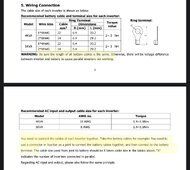Checkthisout
Solar Wizard
- Joined
- Nov 14, 2021
- Messages
- 5,063
What size were the cables, timselectric? Are we ever going to be told?
It seems like one side is pushing speculation and anecdotal 'evidence' without any recourse to actual figures, and the other is looking at the figures and deciding it isn't going to be a problem.
Eggs posted a page from the manual.
I would love to dog pile but I'll be a voice of reason.
1) Why did you ask in the first place?
2) Why didn't the instructions regarding cable length in the manual get followed?
3) Assembly line nature of things would have dictated making 4 equal length cables and not taking up precious milliseconds measure for two different cable lengths.
4) It's a matter of zero consequence because what you're going to do after install is run the system up to redline and check for hot cables and connections. At this time, you can check the voltage at each inverter. If the one with the longer cables has higher voltage drop, you can just call your sparky back and have him make two new cables.
Of all the points where cable length is critical, its there.



